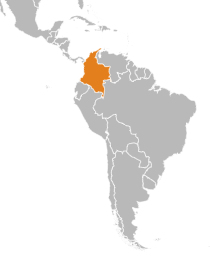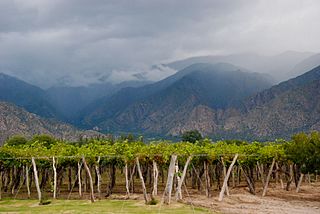By Nick Giambruno

If you’ve seen a movie with this stuff in it, there’s a good chance it was set in Colombia.
Popular culture has depicted Colombia this way for decades. The media has pounded this image into the public’s consciousness. So it’s no surprise most people think of the country as a scary, dangerous place.
There were plenty of facts to support this image 30 years ago…but not today. Today, a violent Colombia is just a Hollywood fiction.
The real Colombia has one of thefastest growing economies in Latin America. Some remote areas are still no man’s land. But the drug wars and civil conflict that started in the 1960s and tormented much of the country have wound down. I’d feel much safer walking down a street in Medellín tonight than I would in many parts of New York City, Chicago, or Washington, D.C. Plus, unlike most Latin American countries, Colombia welcomes and respects foreign investment.
It’s clear to anyone who has been there recently that Colombia has turned a page to a better future. The country has immense charm and plenty of opportunity for investors. That was certainly my impression after visiting earlier this year.
Yet the average person still thinks it’s the 1980s. He’s still holding onto ill-founded fears, thanks to all the negative but out-of-date images in the media. These images have created gross misperceptions about Colombia. That’s not a bad thing for us. It’s an opportunity.
The perception gap about Colombia has pushed the price of most things down to bargain levels. This is a blessing to anyone who can see beyond it.
This is exactly why I visited Colombia earlier this year. I found the opportunities there so compelling that I purchased a beautiful penthouse apartment in the nicest part of Medellín. I signed the papers and closed in early September.
Colombia, and Medellín in particular, has been on my radar for many years. My old college roommate was originally from Medellín. So I’ve known what the place was really like for some time.
I’ll share more on the investment opportunities in Colombia in a bit. But first, some important background information…
Peace Brings Prosperity
In the 1960s, friction between leftist guerrillas (generally allied with drug lords), right-wing militias (in some cases dabblers in the drug trade), and the Colombian central government developed into widespread civil conflict. This is the main reason Colombia has had a “red alert” travel advisory next to its name for decades.
The leftist guerrilla armies, Fuerzas Armadas Revolucionarias de Colombia (FARC) and the much smaller Ejército de Liberación Nacional (ELN), were the most notorious source of violence. Farming families started militias to fight back against FARC and ELN. They needed protection and, for many years, they were skeptical about the central government’s ability to provide it.
At one point, the leftist guerrillas controlled nearly half the country. But over the years, FARC lost territory, membership, and military strength.
The success of the Colombian military is one reason FARC’s power has shriveled. The military has pushed FARC out of most of the country.
Another reason is that FARC lost its foreign patrons. Cuba had been one of FARC’s biggest sources of financial and military support. But with the collapse of the Soviet Union, the Cuban government lost its ability to finance mischief in Colombia, or elsewhere.
Cuba’s reconciliation with the U.S. has recently changed the geopolitical equation even more.
Add it up, and it’s no surprise FARC thinks more armed conflict is a losing bet. The remaining FARC forces have reached a tentative peace agreement with the Colombian government. They plan to finalize the agreement by March 2016.
In the coming months, I think there’s a good chance the Western Hemisphere’s longest-running conflict will come to a clean finish.
Below is a picture of Cuban president Raúl Castro bringing together Colombian President Juan Manuel Santos and FARC leader Rodrigo Londoño Echeverri, better known by the nom de guerre Timochenko.

A Contrarian Investor’s Dream
Colombia has the right mix of ingredients to make any contrarian salivate. Most people think it’s a country in crisis. In reality, that crisis is only a memory.
The world’s attachment to an outdated Hollywood stereotype of a country overrun by battling drug lords is handing us an opportunity. This stereotype, which is just beginning to fade, has kept prices of Colombian land and Colombian stocks low. And the recent strength of the U.S. dollar has pushed prices even lower.
It’s clear to me – and should be clear to anyone who has visited recently – that Colombia has turned a page to a better future. The country’s middle class is vibrant and growing. It has more than doubled in the past 13 years and now includes more than 30% of the population.
Massive, intelligently planned infrastructure projects are underway. An ambitious four-lane highway will cut through the Andes with tunnels and bridges to connect Medellín to ports on the Pacific and the Caribbean. It will also open up vast tracts of rich farmland for development.
Walk anywhere in Medellín and you will feel a dynamic energy in the air that tells you this place is on an upswing.
Put it all together, and you have a perfect crisis market…a place where the crisis is a fiction.
These opportunities won’t last forever. The word is starting to get out. But, for the time being, Colombia hasn’t hit the radar of most foreign and institutional investors. However, that could change soon, especially if the government and FARC reach a permanent peace agreement in the months ahead, as I expect they will.
How to Profit
One way to invest in Colombia is to buy stock in Colombian companies. A handful of them trade in New York, just like any other public company.
I’ve uncovered what I think is the best Colombian company to invest in right now. I think it’s an incredible bargain. This stock has a safe double-digit yield and lots of capital appreciation potential.
Investing in Colombian real estate is another way to profit.
Besides the compelling investment and lifestyle aspects, there are other solid reasons to own property outside of your home country.
I often describe owning foreign real estate as an “international diversification grand slam.” It can accomplish five key goals all at once. For example, the apartment I bought in Medellín gives me the following benefits:
1. Geographically and politically diversified savings. I essentially traded overvalued paper money (U.S. dollars) for an undervalued hard asset out of the immediate reach of the U.S. government. It’s extremely unlikely that your home government could ever confiscate your foreign real estate.
(Besides Colombia, I view Argentina as very attractive right now. With the election of the pro-market Mauricio Macri, there’s a good chance Argentina is turning the corner to a brighter economic future. That, and the incredible lifestyle there, is why Argentina is at the very top of my shopping list.)
2. An easy path to residency in Colombia. Colombia, like many countries, will give real estate investors residency or a path to it. With the apartment and Colombian residency in hand, I have an emergency “bolt-hole” where I could always go if necessary.
3. Portfolio diversification. The apartment diversifies the mix of asset classes in my investment portfolio. It also gives me the option to generate foreign currency cash inflows from rental income.
4. A measure of privacy. I’ve also described foreign real estate as the “new Swiss bank account.” That’s because owning foreign real estate is one of the very few ways Americans can legally keep some of their wealth abroad while maintaining their privacy.
5. Additional crisis insurance. Given the degrading social, political, and economic trends of the U.S., I think it’s critical to take proactive measures now.
Decades of bad financial decisions and massive debt levels will cause another financial crisis sooner rather than later. Central bankers and politicians are playing with fire and inviting a currency catastrophe.
That’s a big reason why I decided to invest in foreign real estate. But that’s not the only protective measure you can take. I recommend owning physical gold and silver coins for similar reasons.
There are many other practical steps you can take to crisis-proof your savings.
You might also like:




Thanks for the tip on Columbia. It’s safe to go back there now and rip off the natives. Why don’t you go take a night drive in Nica? They aren’t as tame there. Love live the multi national corporate empire. Yer a creep.
Who said anything about ripping off locals? A lot of “Norte Americanos” are retiring to Central and South America and thus are pumping money into the local economies. Some start small businesses which also helps fill local needs and provides jobs for locals, some donate time and money to local community service projects, starting Libraries, working in orphanages, dog rescue and a variety of other projects. Most Central and South Americans have much more welcoming attitudes than you do and are happy to have “Norte Americanos” as neighbors. But the article specifically mentioned buying stock in Colombian businesses thus helping them to provide jobs for their countrymen. What’s wrong with that?